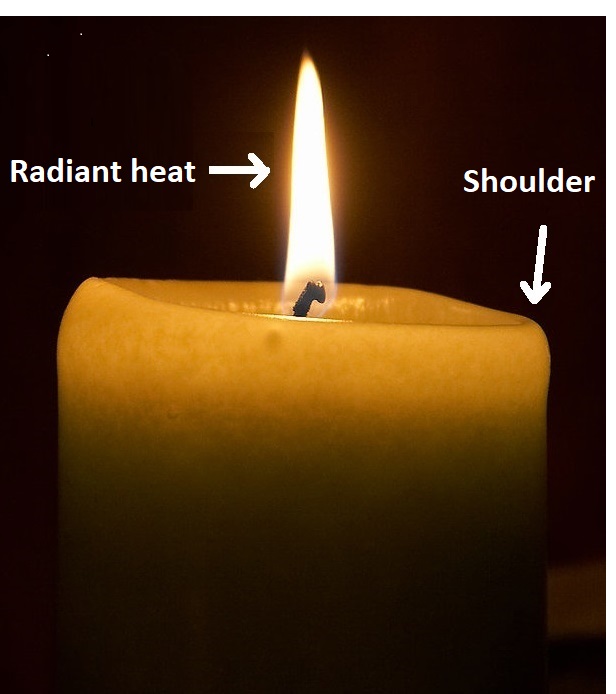This newsletter is being sent as an educational service to your Church. This is the second in a series of short articles on getting the most out of your altar candles. These will be excerpted from the booklet “The Light in Your Church – A Guide to Carefree Money Saving and Green Use of Candles in the Church“ authored by Ross Raby, Director of ChurchWares Direct. We hope you will find this very useful.
Whether you are using beeswax candles, a liquid paraffin wax refill system or a votive candle rack that recycles its own wax, there is one thing that always stands true: Candlelight can add to the atmosphere and enjoyment of services in all church denominations, as well as lend warmth and elegance to your own home.
However, many people use much less candlelight than they would like because of the problems of smoking, dripping and cleaning up that many associate with candle-burning.
In the case of refillable liquid paraffin systems, many unscrupulous church suppliers have gone so far as to lie to their customers, saying they are somehow dangerous. This is because they don’t carry these products and with good purpose: they make a very good profit selling disposable cartridges or other products such as cheap or sooty candles made outside of North America. The last thing they want churches to know is that it is perfectly safe and that they can save up to 80% on candles by following the advice in this series.
Its important to understand what makes a well-made candle, and the options which are available to you to save you money and be more environmentally responsible. Understanding what goes on in a well-made candle as it burns, and knowing what factors can disturb the burning process, can help you get the maximum enjoyment out of your candles.

In a perfect candle, the blends of waxes, type of wick and the candle diameter are all expertly matched so that, during burning, a continuous, balanced, cycle of events is taking place; hot air rises upward, away from the candle, while heat from the flame radiating downward melts just the right amount of wax, which rises up the wick by capillary action to produce just the right flame. (Wax must first liquefy in order to be soaked up the wick to burn.)
The perfect candle is clean-burning, smoke-free and drip-free because the combustion of the liquid wax is complete and the heat produced melts the exact amount of wax to feed the required flame. Everything is in balance. This is possible in beeswax, liquid paraffin refillable systems and paraffin candles, providing they are made of pure ingredients, not poorly or cheaply constructed, and are used in the correct manner.
We have spoken to you a bit about the many different options and I think you now understand – candle problems come from ingredients, quality or construction flaws and misuse – NOT by the “type” of system you use – there is good and bad in all. And it can be difficult to tell the difference. Next, we will cover some things you need to look out for.
The Not-So-Perfect Candle
A not-so-perfect candle lacks the balance in its construction we just discussed. For example, if the wick is too long, the flame will be too big, too much wax will be melted, and the candle will drip or smoke, or both! When the wick is too short or the candle diameter too large, the flame will be too small and the candle will not liquefy across its full diameter, causing it to burn down the middle only.
External factors
Even a perfect candle has to function in an imperfect world, and there are a number of external factors that can affect candle performance. Remember, wax or paraffin has to liquefy in order to burn and it can never do so without BOTH a wick and a flame present. Each burning candle has a little pool of liquefied wax or paraffin balanced on its top. If the candle, or the candlestick, is leaning or wobbly, wax or paraffin may drip or be splashed. If someone blows the candle out instead of using a snuffer, the wax may be blown off the candle and onto carpets, floors, or linens. And if a candle is extinguished and immediately moved before the liquid has congealed, that liquid may be spilled. That is money wasted, and an unnecessary mess.
Preventing these problems is as easy as following these simple rules:
Be sure the surfaces on which candlesticks are placed are solid. This seems obvious, but shaking tables or floor movement is greatly amplified at the top of a candle
Check your candlesticks to see that they are straight, have feet or a base that provides an even footing, and have a socket that provides a perfect, snug fit for the chosen
Fit the correct size candle firmly and straight into the
Use a snuffer to extinguish the candle, then leave the candle at rest for about 10 minutes to give the wax time to harden.
Other Possible Concerns
Yet another problem that can occur is this: remember that the heated air rises away from the candle and that it is the radiant heat shining down that melts the wax. Air currents can upset this balance.
If ceiling fans, air conditioners, open doorways, or other breezes cause the flame to be deflected, hot air can be blown downward, resulting in excessive melting of the wax.
Then, either the wax will be only partly burned — with the incomplete combustion being seen as black smoke (carbon soot), or the wax will run down the side of the candle, or both.
The simple solution to this last problem is contained in our next newsletter where we will discuss the use of followers.
